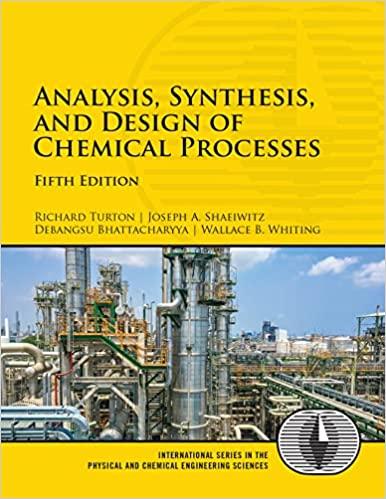Ethylene and air react in a vapor-phase catalytic reaction to form ethylene oxide. The system can be
Question:
Ethylene and air react in a vapor-phase catalytic reaction to form ethylene oxide.![]()
The system can be modeled by the PR EOS. The rate law is given by Wan![-TCH4 k = 324exp 1/3 2/3 kmol KPC HAPO kg cat s -19,300 cal RT [K] E = 19,300 cal mol kmol atm kg cat s](https://dsd5zvtm8ll6.cloudfront.net/images/question_images/1699/3/5/4/070654a15d6a5bab1699354065990.jpg)
Develop a base-case simulation considering a feed stream with ethylene and O flowrates of 4 kmol/s and 2 kmol/s, respectively. The streams are available at 25 bar and 230°C. Simulate the reactor as a PFR with a constant temperature of 260°C. Consider using a total of 7500 carbon steel, catalyst-filled tubes, each with an inside diameter of 0.0254 m. Consider the bed voidage to be 0.45 and the density of the catalyst particles to be 1922 kg/m3. Consider an appropriate correlation for calculating the pressure drop through the reactor. What is the length of individual tubes for achieving 40% conversion of ethylene?
Now consider that the heat of reaction is being used for generating steam at a constant temperature of 230°C. Modify the previous reactor model to a nonisothermal reactor, calculating the heat transfer coefficient in a UAM. The UAM can be developed in FORTRAN, C, or Excel or by using any other suitable interface supported by your simulator. The UAM will retrieve the stream conditions (such as flowrates of the reactants) and physical properties (such as viscosity, density, specific heat, thermal conductivity) of the feed calculated by the process simulator. Use the inlet condition data for calculating the heat transfer coefficient with the Gnielinski correlation:![Nu (Re-1000) Pr(0/8) 1+12.7 /8(Pr2/3-1) = [0.79 In (Re) - 1.64] -2](https://dsd5zvtm8ll6.cloudfront.net/images/question_images/1699/3/5/4/150654a1626ab7cb1699354145826.jpg)
Automatically insert the calculated heat transfer coefficient in the specification of the reactor. The reactor temperature must be maintained below 270°C to avoid explosion. Retrieve the maximum temperature of the reactor to the UAM and the amount of unreacted ethylene in the outlet stream. What is the maximum temperature?
Now modify the reactor design (number of tubes, tube diameter, and length) so that you can achieve 40% conversion of ethylene without the maximum temperature exceeding 270°C. The maximum temperature is expected to occur somewhere along the length of the reactor, not necessarily at the outlet. The reactor design parameters should be automatically inserted by the UAM into the process simulator along with the recalculated heat transfer coefficient. What are the final values of your design parameters?
Consider the previous UAM. Keep the reactor design parameters constant. From the UAM, vary the ethylene flowrate by +/ −30%, keeping the stoichiometric ratio of O constant. How much conversion of ethylene did you achieve in the extreme conditions? Could you satisfy the temperature limit? If not, modify the reactor design so that you can satisfy the temperature limit in this operating range. Note that you will still need to ensure that 40% conversion of ethylene is achieved when the flowrates are at their base-case values.
Step by Step Answer:

Analysis Synthesis And Design Of Chemical Processes
ISBN: 9780134177403
5th Edition
Authors: Richard Turton, Joseph Shaeiwitz, Debangsu Bhattacharyya, Wallace Whiting





